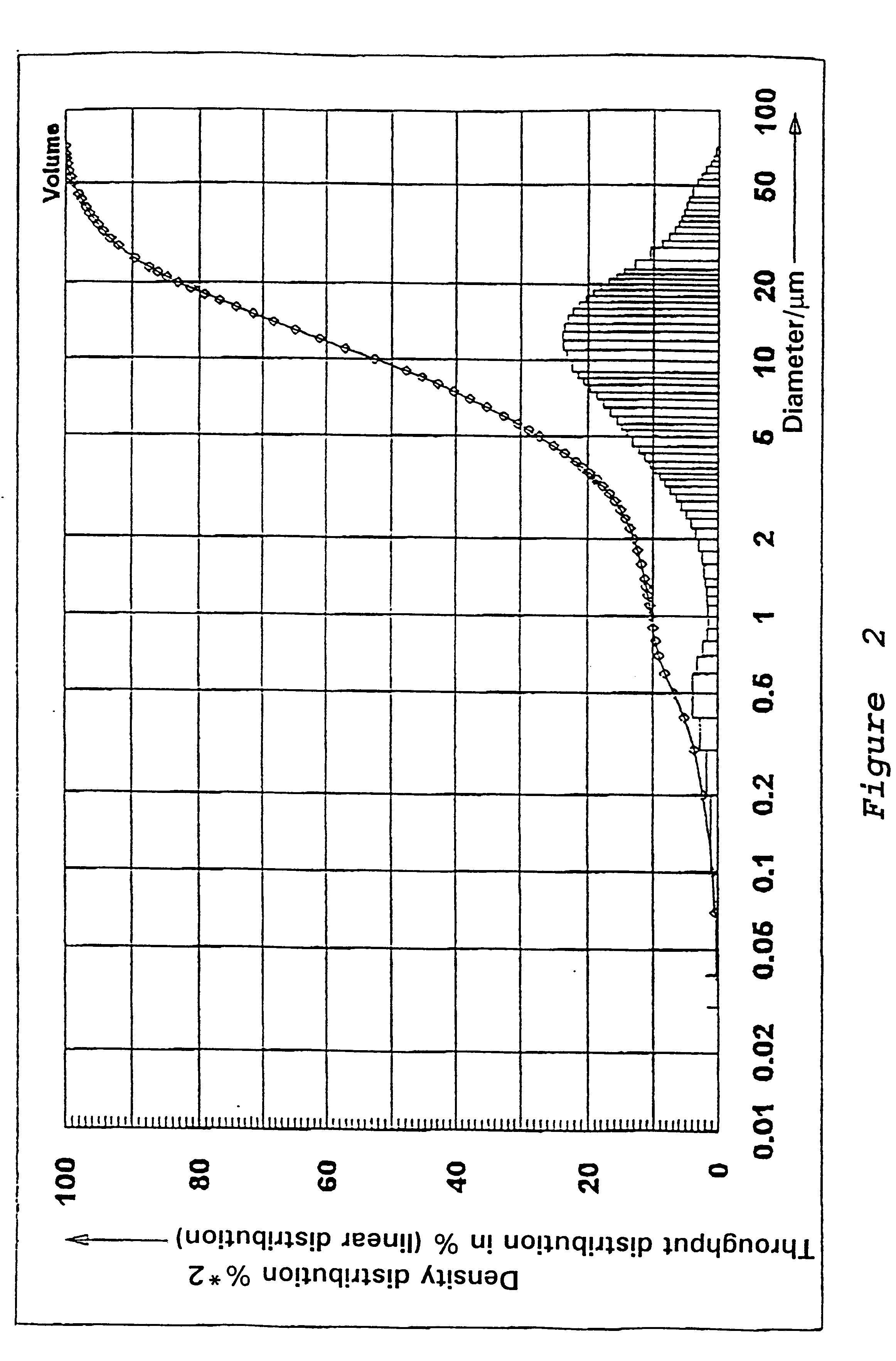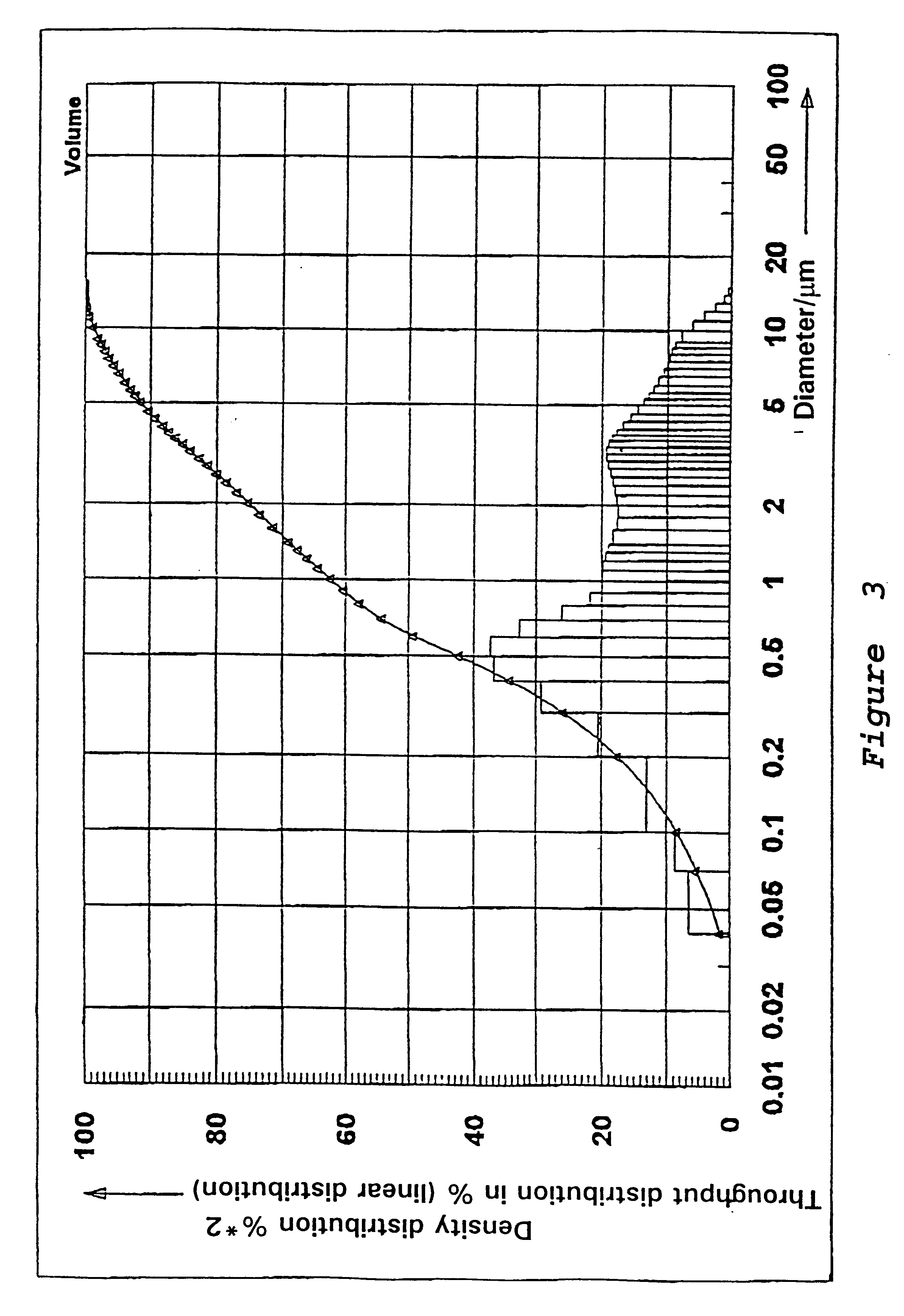Precipitated silicic acid
a precipitated silicic acid and silicic acid technology, applied in the field can solve the problems of poor dispersibility, inability to achieve the effect of precipitation, and insufficient dispersion of precipitated silicic acid for tire treads, etc., and achieve the effect of easy dispersibility in tire carcasses
- Summary
- Abstract
- Description
- Claims
- Application Information
AI Technical Summary
Benefits of technology
Problems solved by technology
Method used
Image
Examples
example 1
Preparation of a Precipitated Silica in the N.sub.2 -range from 120 to 140 m.sup.2 / g
46 m.sup.3 of water are heated in a vat to 88.degree. C. while stirring. While maintaining the temperature at 88.degree. C. there are added at pH 9.0, which is adjusted by addition of water glass, sufficient water glass (modulus 3.42, density 1.348) and 96% sulfuric acid under constant stirring, so that after 125 minutes a solids content of 88.5 g / l is reached. In addition 265 l of an aluminum sulfate solution (density 1.28) are metered in at the same time while stirring constantly. Sulfuric is then added until a pH of between 3 and 5 is reached. The solid is separated on a filter press, washed, and then dried and if necessary ground.
The precipitated silica obtained has the following physico-chemical data:
example 2
Preparation of a Precipitated Silica in the N.sub.2 -range from 130 to 150 m.sup.2 / g
53.5 l of water are heated to 80.degree. C. in a vat while stirring. While maintaining the temperature at 80.degree. C., there are added at pH 9.0, which is adjusted by adding water glass, sufficient water glass (modulus 3.42, density 1.348) and 50% sulfuric acid under constant stirring, so that after 67 minutes a solids content of 92.9 g / l is reached. In addition 0.255 l of an aluminum sulfate solution (density 1.28) is metered in while stirring constantly. Sulfuric acid is then added until a pH of between 3 and 5 is reached. The solid is separated on a filter press, washed, and then subjected to a brief or prolonged drying and if necessary ground.
The precipitated silica obtained has the following physico-chemical data:
example 3
Preparation of a Precipitated Silica in the N.sub.2 -range from 120 to 140 m.sup.2 / g
54.6 l of water are heated to 80.degree. C. in a vat while stirring. While maintaining the temperature at 80.degree. C. there are added at pH 9.0, which is adjusted by adding water glass, sufficient water glass (modulus 3.42, density 1.348) and 50% sulfuric acid under constant stirring, so that after 67 minutes a solids content of 91.4 g / l is reached. In addition 0.784 l of an aluminum sulfate solution (density 1.28) is metered in while stirring constantly. Sulfuric acid is then added until a pH of between 3 and 5 is reached. The solid is separated on a filter press, washed, and then subjected to a brief or prolonged drying and if necessary ground.
The precipitated silica obtained has the following physico-chemical data:
PUM
| Property | Measurement | Unit |
|---|---|---|
| concentration | aaaaa | aaaaa |
| pH | aaaaa | aaaaa |
| temperatures | aaaaa | aaaaa |
Abstract
Description
Claims
Application Information
 Login to View More
Login to View More - R&D
- Intellectual Property
- Life Sciences
- Materials
- Tech Scout
- Unparalleled Data Quality
- Higher Quality Content
- 60% Fewer Hallucinations
Browse by: Latest US Patents, China's latest patents, Technical Efficacy Thesaurus, Application Domain, Technology Topic, Popular Technical Reports.
© 2025 PatSnap. All rights reserved.Legal|Privacy policy|Modern Slavery Act Transparency Statement|Sitemap|About US| Contact US: help@patsnap.com



